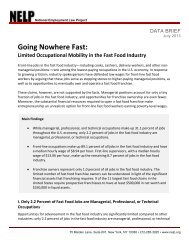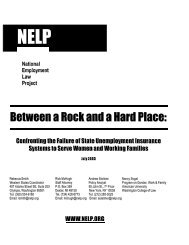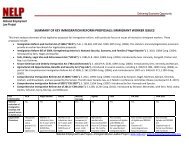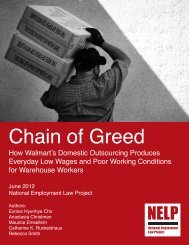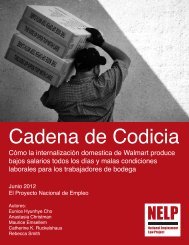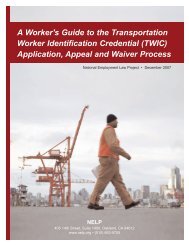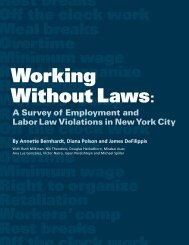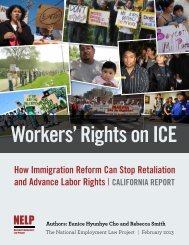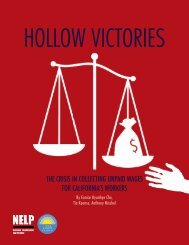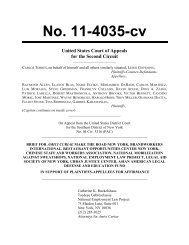Rebuilding Lives. Strengthening Communities.
Rebuilding Lives. Strengthening Communities.
Rebuilding Lives. Strengthening Communities.
Create successful ePaper yourself
Turn your PDF publications into a flip-book with our unique Google optimized e-Paper software.
Introduction (cont.)<br />
22<br />
Long, Ray and Christi Parsons, “Budget Buzzer Beater; State Democrats Push Plan Through; GOP Complains it is Full of Pork for<br />
Chicago,” Chicago Tribune, June 1, 2005.<br />
23<br />
Street, Paul, “The Vicious Circle: Race, Prison, Jobs, and Community in Chicago, Illinois, and the Nation,” (Chicago, IL: Chicago<br />
Urban League, 2002), http://www.cul-chicago.org/72329633112722/lib/72329633112722/the%20vicious%20circle.pdf (accessed<br />
December 1, 2005), 3.<br />
24<br />
Corrections represented 5.2% of Illinois’ FY 2005 General Revenue Fund. Office of Management and Budget, “Illinois State Budget<br />
Book Fiscal Year 2006,” http://www.state.il.us/budget/FY06%20Budget%20Book.pdf (accessed July 7, 2005), 1-8.<br />
25<br />
Butterfield, Fox, “Effect of Prison Building on Crime is Weighed,” New York Times, Sept 28, 2000. See also Jacobson, Michael,<br />
Downsizing Prisons: How to Reduce Crime and End Mass Incarceration (New York, NY: New York University Press, 2005).<br />
26<br />
Travis, Jeremy, Amy Solomon and Michelle Waul, From Prison to Home: The Dimensions and Consequences of Prisoner Reentry<br />
(Washington, D.C.: Urban Institute, 2001), http://www.csosa.gov/Olipa/newsinterest/prison_to_home.pdf (accessed June 16, 2005), 6.<br />
27<br />
U.S. Department of Justice, Bureau of Justice Statistics, “Recidivism,” Reentry Trends in the United States,<br />
http://www.ojp.usdoj.gov/bjs/reentry/recidivism.htm (accessed June 16, 2005).<br />
28<br />
La Vigne, Nancy G. and Cynthia A. Mamalian, “A Portrait of Prisoner Reentry in Illinois” (Washington, D.C.: The Urban Institute,<br />
2003), 50-51.<br />
29<br />
Mumola, Christopher, “Incarcerated Children and Their Parents,” Special Report (Washington, D.C.: Bureau of Justice Statistics, 2000), 7.<br />
30<br />
Travis, Jeremy, Elizabeth M. Cincotta, and Amy L. Solomon, Families Left Behind: The Hidden Costs of Incarceration and Reentry<br />
(Washington, D.C.: Urban Institute, 2003), http://www.urban.org/UploadedPDF/310882_families_left_behind.pdf (accessed June 7,<br />
2005), 2.<br />
31<br />
Travis, Jeremy and Michelle Waul, “Prisoners Once Removed: The Children and Family of Prisoners,” in Prisoners Once Removed: The<br />
Impact of Incarceration and Reentry on Children, Families and <strong>Communities</strong>, ed. Jeremy Travis and Michelle Waul,<br />
http://www.urban.org/pubs/prisoners/chapter1.html (accessed June 16, 2005).<br />
32<br />
U.S. Department of Justice, Bureau of Justice Statistics, “Demographic Trends of Correctional Population by Gender,”<br />
http://www.ojp.usdoj.gov/bjs/glance/tables/cpgendtab.htm (accessed July 1, 2005).<br />
33<br />
Senate Report 106-404: Departments of Commerce, Justice and the State, the Judiciary and Related Agencies Appropriation Bill, 2001,<br />
U.S. Senate. September 8, 2000, indicates that “children of prisoners are six times more likely than other children to be incarcerated at<br />
some point in their lives.” Quoted in “Services for Families of Prison Inmates,” Special Issues in Corrections, U.S. Department of<br />
Justice, National Institute of Corrections (February 2002) http://www.nicic.org/pubs/2002/017272.pdf (accessed November 5, 2005), 3.<br />
34<br />
Harrison, Paige and Allen Beck, “Prisoners in 2004” (Washington, D.C.: Bureau of Justice Statistics, 2005),<br />
http://www.ojp.usdoj.gov/bjs/pub/pdf/p04.pdf (accessed November 11, 2005), Table 10.<br />
35<br />
Harrison, Paige and Allen Beck, “Prisoners in 2004” (Washington, D.C.: Bureau of Justice Statistics, 2005), Table 11,<br />
http://www.ojp.usdoj.gov/bjs/pub/pdf/p04.pdf (accessed November 11, 2005). Some scholars and commentators argue that there is a<br />
simple explanation for these statistics: African Americans commit more crimes. But even if that were true, it would not explain the<br />
serious degree of disproportionate treatment that blacks endure in the criminal justice system and has been clearly documented. See<br />
http://ojjdp.ncjrs.org/dmc/.<br />
36<br />
Mauer, Mark and Tracy Huling, “Young Black Americans and the Criminal Justice System: Five Years Later” (Washington, D.C.: The<br />
Sentencing Project, 1995), 1.<br />
37<br />
Bonzcar, Thomas, “Prevalence of Imprisonment in the U.S. Population, 1974-2001,” (Washington, D.C.: Bureau of Justice Statistics,<br />
2003) http://www.ojp.usdoj.gov/bjs/pub/pdf/piusp01.pdf (accessed November 11, 2005), Figure 3 and Figure 4.<br />
38<br />
See Illinois Quick Facts from U.S. Census Bureau, http://quickfacts.census.gov/qfd/states/17000.html (accessed November 11, 2005)<br />
and Illinois Department of Corrections, “2004 Departmental Data Fact Sheet” (Springfield, IL: Illinois Department of Corrections,<br />
2004) http://www.idoc.state.il.us/subsections/reports/department_data/Department%20Data%202004.pdf. (accessed June 16, 2005).<br />
39<br />
Street, Paul, “Race, Place, and the Perils of Prisonomics: Beyond the Big-Stick, Low-Road, and Zero-Sum Mass Incarceration Con,”<br />
Z Magazine (July/August 2005) http://www.prisonpolicy.org/news/zmagjulaug2005.shtml (accessed on November 11, 2005).<br />
40<br />
For instance, within the last decade, the 1996 welfare reform bill placed a lifetime ban on the receipt of welfare and a food stamp benefits<br />
for anyone convicted of a felony drug charge; federal laws passed in 1996 and 1998 allowed for public housing agencies to deny<br />
housing to anyone “engaged in any drug-related activity”; and amendments to the Higher Education Act suspended the eligibility for<br />
student loans to anyone convicted of a drug offense. See Mauer, Marc, “Invisible Punishment: Block Housing, Education, Voting,”<br />
Focus: The Magazine for the Joint Center for Political and Economic Studies, vol. 31, no. 3 (May/June 2003): 3-4.<br />
41<br />
“Prison and Beyond: The Stigma That Never Fades,” The Economist, August 8, 2002,<br />
http://www.economist.com/world/na/displayStory.cfmstory_id=1270755 (accessed November 11, 2005).<br />
42<br />
The Urban Institute webpage, http://www.urban.org/content/PolicyCenters/Justice/Projects/Projects.htm.<br />
43<br />
The Transition from Prison to Community Initiative webpage, http://www.nicic.org/pubs/2002/017520.pdf. Missouri and Oregon were<br />
the first two states selected to test pilot the model. Based on those experiences, NIC expanded the program to four additional sites<br />
including Indiana, Michigan, North Dakota, and Rhode Island.<br />
44<br />
The United States Department of Justice, The Office of Justice Programs webpage, http://www.ojp.usdoj.gov/reentry/learn.html#serious<br />
45<br />
NGA Center for Best Practices, “Issue Brief: NGA Prisoner Reentry Policy Academy” (NGA Center for Best Practices, January 5, 2005),<br />
http://www.nga.org/portal/site/nga/menuitem.9123e83a1f6786440ddcbeeb501010a0/vgnextoid=c223303cb0b32010VgnVCM100000<br />
1a01010aRCRD. Following a national request for proposals, teams from seven states—Georgia, Idaho, Massachusetts, Michigan, New<br />
Jersey, Rhode Island, and Virginia—were invited to participate.<br />
MAYORAL POLICY CAUCUS ON PRISONER REENTRY<br />
113





